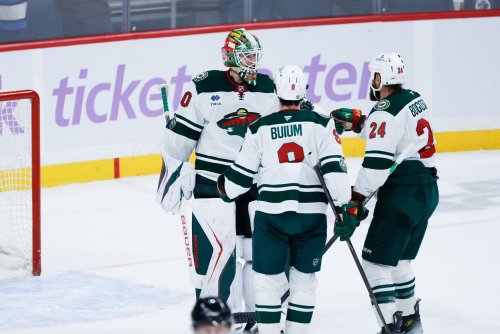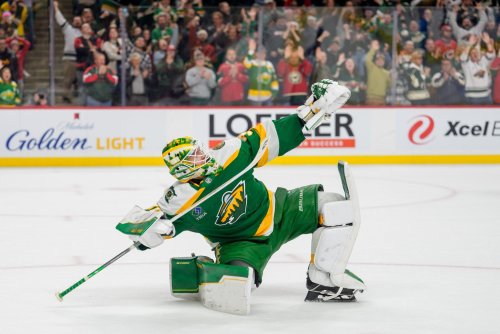
There are certain truths about this Minnesota Wild team with which we must come to terms. They will be in the postseason. They have won seven games in a row and have outscored their opponents 32-14 during the winning streak.
And they are also backing into the playoffs. Sorry to throw cold water on this hot streak.
Yes, the Wild have won seven consecutive games, but they have been against the worst teams in the West Division. The San Jose Sharks have some of the worst goaltending in the league, Minnesota owns a majority stake in Darcy Kuemper’s mind and the Los Angeles Kings won’t have much in the way of scoring talent right now.
The fact is, the Wild looked like world-beaters against inferior competition — as they should.
And they are winning despite playing poor hockey.
While the Wild are 13-5-2 in the last 20 games, they’ve been outshot in every game. Score effects -- or the tendency of the team leading in the third period to be less aggressive -- are certainly part of this equation, but that doesn’t explain all 20 games. Since March 18, the Wild have given up 247 shots on goal, or 57.2% of the shots while at 5-on-5 when tied or down by a goal. The Wild aren’t controlling the game when the game is still in the balance.
Shots might not tell the whole story. The Wild have tended to lose the shot-attempt battle within games, but they manage to own the expected-goals war. Expected goals, in other words, mean scoring chances. This was true early in the season. In fact, it’s what Minnesota has known for among hockey data analysts for the past few seasons.
That hasn't been the case since the infamous Av-pocalypse. Minnesota went from a plus-12.45 xGF differential to a brutal minus-3.05. And while everyone sees them floundering, changing up the status quo couldn't be further from the minds of the Wild brass.
Minnesota was outshot 10-1 in the first nine and a half minutes of the first period against the Arizona Coyotes. They were outshot 40-23 for the game. When they took on the Kings a few nights later, it was like watching a movie scene on repeat. Los Angeles won the shots battle in every period en route to a 42-24 shooting margin over the Wild. With Dean Evason, nothing has changed. Outside of adding Marcus Foligno to the lineup, the same lines are repeatedly sent over the boards.
The Wild had a terrible process but were winning because of a hot goalie. There a no shortage of compliments and adulation for Cam Talbot and what he's meant to the Wild this season. That is due to come crashing down at some point. A team cannot get away with allowing their goalies to be shelled on a nightly basis and expect to win when the stakes ramp up. This is exactly what the 2014 Colorado Avalanche were rudely awakened to when the Wild defeated them in the first round of the Stanley Cup Playoffs.
With the Wild clinching so early, they must fine-tune their game to really compete with the big dogs of the West — and beyond, should they make it that far. Except there seems to be little appetite from the Wild coaching staff to try new things.
If a healthy Nick Bjugstad cannot crack this lineup, then top prospect Matt Boldy doesn’t stand a chance of seeing time in the final 10 games. The Wild don’t seem to be in a hurry to find out if Boldy can be an ace in the hole for them come playoff time. With the NHL squad now back home, and Iowa waiting to embark on their weekend series with the Chicago Wolves, Boldy can be called up without needing to satisfy a quarantine period. Now would be the best time for his audition.
There’s no reason not to.
Minnesota knows they've made the postseason, and they’re pretty solidly in the third spot. So while there might be an outside chance at running the table -- while catching some luck along the way -- and securing the top spot in the West, they won’t come close by playing the way they have been. Evason should be looking at adding a young prospect who features good size and upper-echelon hands like Boldy. He's shown that the AHL hasn't been too big for him. He jumped right in by adding nine points in seven games with Iowa. If Jordan Greenway was worthy of jumping right from Boston University to the NHL and into the postseason the year he signed his entry-level deal with the Wild, Boldy most certainly fits the bill.
Granted, the Greenway decision was made by a different coaching staff and GM. But what is the point of keeping Boldy stashed in the AHL? The first year of his ELC has been burnt. It's gone. There is no incentive for service time by keeping him in the minors. The Wild didn't make a move at the trade deadline, and Bill Guerin said publicly that he told other GMs they were standing pat.
If Foligno coming off the injured reserve can be viewed as making an addition at the deadline, then calling Boldy up makes even more sense. To not make any changes to the roster, either externally or within, is a loser's mentality. It's the same dialogue the Twins come up with when they fail in free agency or at the trade deadline. And just like the Twins, until the on-ice product improves, either by mixing up the lines or in some other fashion, the Wild will meet the same fate as the team across the Mississippi River.
Until they show that they can do more than just weather a storm and steal games by shooting 24.22% (as they did in April) on the power play, they need to make changes. Their approach has been if something isn't broken, don't fix it. But the Wild's recent winning streak might as well be a fresh coat of paint over a rusted-out chassis. If someone is looking under the hood, some repairs are required before anyone can say that Minnesota is a well-oiled machine.
Think you could write a story like this? Hockey Wilderness wants you to develop your voice, find an audience, and we'll pay you to do it. Just fill out this form.








Recommended Comments
There are no comments to display.
Join the conversation
You can post now and register later. If you have an account, sign in now to post with your account.
Note: Your post will require moderator approval before it will be visible.